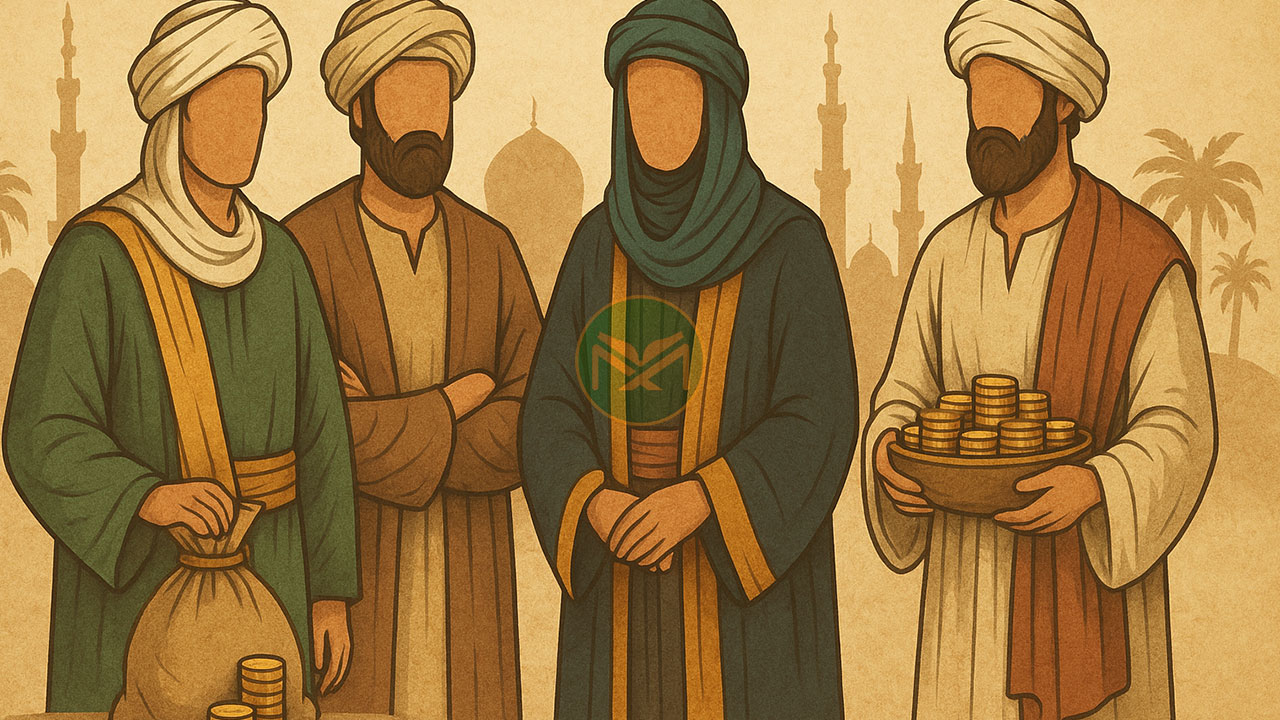The Richest 10 Companions of Prophet Muhammad

An Economic Reflection on the Richest Companions of the Prophet
When we reflect on the lives of the Prophet Muhammad’s companions who were known for their piety and asceticism, we may be surprised to learn that many of them amassed significant wealth by the standards of their time. The paradox is not in their possession of wealth, but in how they managed it, earning it wisely, spending it generously, and never allowing it to own their hearts.
Wealth Built on Trade and Conquests
The wealthy companions relied primarily on free trade in the markets of Mecca and Medina, where commercial activity was thriving even before Islam. Abdur-Rahman ibn Awf, for instance, started from scratch in Medina by selling dairy and fat, gradually expanding until he became one of its top merchants.
The real turning point came during the caliphate of Umar ibn al-Khattab, when the spoils of Islamic conquests began pouring into the Muslim heartland. These massive new financial inflows reshaped the region’s wealth distribution. The companions wisely reinvested in real estate, agriculture, and livestock trading, eschewing hoarding in favor of circulation and growth.
List of the 10 Richest Companions of Prophet Muhammad
Among the wealthiest companions:
- Abdur-Rahman ibn Awf: His wealth exceeded 3.2 million dinars. He donated an orchard valued at 100,000, pledged 1,000 horses for Allah’s cause, and gave 400 dinars to every veteran of Badr.
- Uthman ibn Affan: Amassed 30 million dirhams plus 150,000 dinars in gold. He funded the digging of the famous Well of Rumah and fully equipped the army in the Tabuk campaign.
- Az-Zubair ibn Al-Awwam: Left behind approximately 50 million dirhams in real estate and cash. He owned 11 houses in Medina, with revenues dedicated to repaying his debts and later supporting his grandchildren’s orphans.
- Talhah ibn Ubaydullah: His daily earnings were reported at 1,000 dirhams, and his land in Iraq generated 400–500 thousand dirhams annually. He once gifted land worth 300,000 dirhams to a relative and supported all his extended family members.
- Sa’d ibn Abi Waqqas: His estate was valued at 250,000 dirhams, not including his share from the Persian conquests. He intended to give away two-thirds of it in charity, but the Prophet ﷺ advised him to limit it to a third, “and a third is still a lot”.
Others in the second tier of wealth, based on narrations from scholars like Ibn Sa’d and Al-Dhahabi, include:
- Amr ibn Al-As: Left behind approximately 140 ardeb (large sacks) of gold, several tons by modern standards. He endowed land in Egypt to fund military needs and public treasuries for a whole year.
- Abdullah ibn Abbas: Received an annual stipend of one million dirhams from Muawiyah in recognition of his intellectual and social influence. He personally covered the needs of pilgrims in Mecca for several years.
- Zayd ibn Thabit: Left behind so much gold and silver that it had to be broken with axes. He founded endowments for Quran students and was Medina’s chief jurist and mufti.
- Abu Bakr As-Siddiq: Had 40,000 dirhams at the time of his conversion, all of which he spent for Islam. He freed seven slaves and gave away all his wealth at the Battle of Tabuk, dying without a single coin.
- Abu Ayyub Al-Ansari: Known for his simplicity, yet he left behind a large orchard in Medina and valuable lands in Egypt, acquired through stipends and conquests. He endowed them to support the poor and travelers to Medina.
Wealth in the Hand, Not in the Heart
The generosity of these companions preceded their reputation for wealth. Abdur-Rahman ibn Awf, for example, was known for massive donations well before he became publicly regarded as rich. Abu Bakr spent his entire fortune twice: once upon embracing Islam and again at Tabuk, leaving nothing behind. Az-Zubair and Sa’d both instructed that debts be paid before any inheritance was distributed.
Shared Economic Traits
A close analysis reveals several common characteristics among these wealthy companions:
- Traders before leaders: Most were successful businessmen before holding public office.
- Interest-free finance: They dealt in trade and deferred sales, not usurious loans.
- Debt first: Many, including Az-Zubair and Sa’d, prioritized paying off debts before dividing wealth among heirs.
- Charity with limits: The one-third rule became a jurisprudential standard to ensure heirs’ rights were not violated.
- Wealth as a means, not an end: None of them were known to build lavish palaces or hoard gold. Instead, they invested in waqf (endowments), charity, and public benefit.
Modern Lessons for Entrepreneurs
Modern entrepreneurs can draw valuable insights from the companions’ financial ethics and practices:
- Specialize before scaling: Abdur-Rahman ibn Awf started by selling dairy and expanded methodically. Begin with a niche and dominate it.
- Diversify your income: Uthman combined trade with real estate investments. Don’t place all your eggs in one basket.
- Maintain liquidity: Talhah’s daily income allowed him to respond to emergencies instantly. Always keep some liquid assets.
- Social responsibility: All these figures embodied a proto-CSR mindset centuries before it became a corporate standard. Tie your profits to long-term, sustainable charitable initiatives.
- Leave a clear will: Transparent inheritance planning and charitable endowments reduce family disputes and preserve capital.
1 Comments
https://filedn.eu/l46Ju9IQhhQ84ifWoIzEYnJ/digi56sa/research/digi56sa-(465).html You can nonetheless embrace those celebratory metallic shades without masking yourself head to toe in sequins.